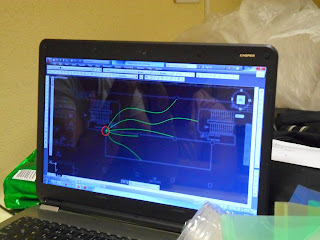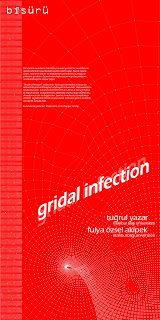INFECTIONSv.2 Re_Flex Patterning
Parametric Design and Fabrication Workshop Series
Re_Flex Patterning
Integrating digital media with material world reveals emergent performances. Parametric modeling techniques encourage designers to study more one the envelopes of potentials instead of singular artifacts. Working with these envelopes reveal a design cycle that entails determination of relations and within this relational framework, dynamics keep design process active and variable. In the serie of workshops titled “Infections”, static and regular patterns of built environment are considered as “host bodies”. Their contextual potentials are revealed and digital technologies start the becoming of these bodies within the concept of infection. In second workshop titled “Re_Flex Patterning”, an atrium is considered as the host body. It will be studied beyond its gridal order, generating re-flex patterns as the initial step on the revealing of it’s potentials. Throughout the workshop, Grasshopper will be used as a tool of parametric modeling and digital deformation techniques, while physical form-finding will be studied on a composite material.
Re_Flex Patterning workshop is conducted at İzzet Baysal University Faculty of Engineering and Architecture between 6-8th May, 2013 by Tuğrul Yazar and Fulya Akipek, from İstanbul Bilgi University Faculty of Architecture.
Re_Flex Patterning workshop is conducted at İzzet Baysal University Faculty of Engineering and Architecture between 6-8th May, 2013 by Tuğrul Yazar and Fulya Akipek, from İstanbul Bilgi University Faculty of Architecture.
About Patterns
Below is a brief explanation of the concept "Pattern";
The etymology of ‘pattern’ is from the Latin pater, or patronus, meaning father, patron, god or master, from which is derived the notion of pattern as a model, example, matrix, stencil or mould. The contemporary concept of pattern is as a sequence, distribution, structure or progression, a series or frequency of a repeated/repeating unit, system or process of identical or similar elements. Synonyms and related concepts include habit, meme, template, motif, configuration, organisation, arrangement, figure, tessellation, system, process, sample, duplicate, convention and texture. This multiplicity of meanings points to the manifold roles of pattern in the creation, reproduction, evolution and processes of space.Garcia, M 2009, 'Prologue for a History, Theory and Future of Patterns of Architecture and Spatial Design', Architectural Design: Patterns of Architecture, vol 79, no 6, M Garcia (ed), Wiley, London, pp.6-18.
The Digital Side
Introduction to Rhino+Grasshopper was the subject of first day's third section. In the second day, we baked the final deformed pattern into AutoCAD to be processed in CNC.
The Grasshopper definition will hopefully be explained in designcoding.net in a couple of days.
Day 3: Final Production
Here are some images of the final day. Approximately 800 polygons are CNC'd and 4500 screws tightened by hand. More photos and information will be added here.
Day 1: Brainstorming
Some photos from the first day.
The "host body" to be infectedAfter initial discussion, we are developing a conceptual framework
Revisiting Infections v1 @ YTU: Plasma
This is the third and the last project of Gridal Infection workshop conducted at YTU.
Conceptual Framework is developed by Betül Dönmez (DEU). In this project, the host body is infected by high fever and pressure, changes its solid phase into plasma. The solid molecules of the existing body transforms to become plasmatic. This substance can react to various movements around it. When someone comes close to the wall, the plasma molecules start to get into motion, unify, expand, and react to push the existing body itself. This transformation of the glass brick wall to plasmatic body makes it more interactive with other bodies around it. The new plasmatic body becomes sensible to the real world and it’s environments. Parametric definition is based on this conception, extended into a geometric solution based on metaballs. After various experiments on the reactions of metaballs, a grid-based deformation is chosen.
Below are the cute initial sketches of Betül, along with screen shots and photographs of the actual installation.
Revisiting Infections v1 @ YTU: Lesion
This is another final project of the three-day workshop at YTU, named Gridal Infection.
Conceptual framework is developed by Bahar Aybudak (METU) and Zeynep Gür (ITU). The cellular forms come together to set the existing wall (host body). The wall represents the body structure, in which in case of any infection, various challenges could be seen in parallel with the immune system. The struggle with the mentioned infection is observed through various transformation in these cells. The location in which these transformations occur is not static but changes according to the infected area (lesion) of the body. Depending on the surrounding movements, some parts are becoming infected and lesions occur. Eventually infections are pushed away from the cells in lesion and a time-based recovery process starts. However, the host body isn’t the same anymore.
Above ideas of the students are realized by implementing a history based truncation process on a regular grid (see figures below). The truncation is associated with movement vectors of Firefly. As it is a time-based algorithm, there are parameters such as “recovery” and “immune system”.
For Grasshopper definition, you search ay designcoding.net
Above ideas of the students are realized by implementing a history based truncation process on a regular grid (see figures below). The truncation is associated with movement vectors of Firefly. As it is a time-based algorithm, there are parameters such as “recovery” and “immune system”.
For Grasshopper definition, you search ay designcoding.net
Revisiting Infections v1 @ YTU: Fiber Grid
Below are the brief results of the first workshop, called "Gridal Infection" conducted at Yıldız Technical University Faculty of Architecture student festival between 4-9 February 2013. It deals more with the "digital side" of the problem, focusing on pattern deformations based on physical inputs such as capturing movement and sound. We used Rhino+Grasshopper+Firefly to realize student projects in this three-day workshop.
The first project called "Fiber Grid"
This is one of the three final projects of the Infections workshop at YTU. Conceptual framework is developed by Begüm Aktaş (YTU) and Merve Özhan (BAU). According to them; the existing host body is a 16×11 unit glass brick wall, which is constructed to separate the corridor of the faculty and to create semi-private spaces for various activities. In this project, the host body is considered as a dead tissue of an organism. Sound is considered as an injection that changes the inner structure of the organism and transform the dead tissues into sensitive fibers. This injection revitalizes the solid and gridal inner structure, and the more it gets fibrous the more it is sensitive. As the surrounding sound rises, the process gets faster and the fibrous structure becomes flexible. This project is realized by developing a grid out of interpolated curves, which are sensitive to a travelling attractor. The movement leaves traces as it is a history-enabled algorithm. Sound is used as another input to manipulate the attractor’s behaviour. Below are screenshots and photographs of the actual installation at YTU. For Grasshopper definition, you may visit designcoding.net
The first project called "Fiber Grid"
This is one of the three final projects of the Infections workshop at YTU. Conceptual framework is developed by Begüm Aktaş (YTU) and Merve Özhan (BAU). According to them; the existing host body is a 16×11 unit glass brick wall, which is constructed to separate the corridor of the faculty and to create semi-private spaces for various activities. In this project, the host body is considered as a dead tissue of an organism. Sound is considered as an injection that changes the inner structure of the organism and transform the dead tissues into sensitive fibers. This injection revitalizes the solid and gridal inner structure, and the more it gets fibrous the more it is sensitive. As the surrounding sound rises, the process gets faster and the fibrous structure becomes flexible. This project is realized by developing a grid out of interpolated curves, which are sensitive to a travelling attractor. The movement leaves traces as it is a history-enabled algorithm. Sound is used as another input to manipulate the attractor’s behaviour. Below are screenshots and photographs of the actual installation at YTU. For Grasshopper definition, you may visit designcoding.net
First Workshop: Gridal Infection
The first workshop in the serie is named "Gridal Infection". Above is the three final projects of this initial experiment.
Welcome
This is the communication platform of Infections 2 Workshop. The whole process will be discussed, recorded and presented here.
Subscribe to:
Posts (Atom)













































